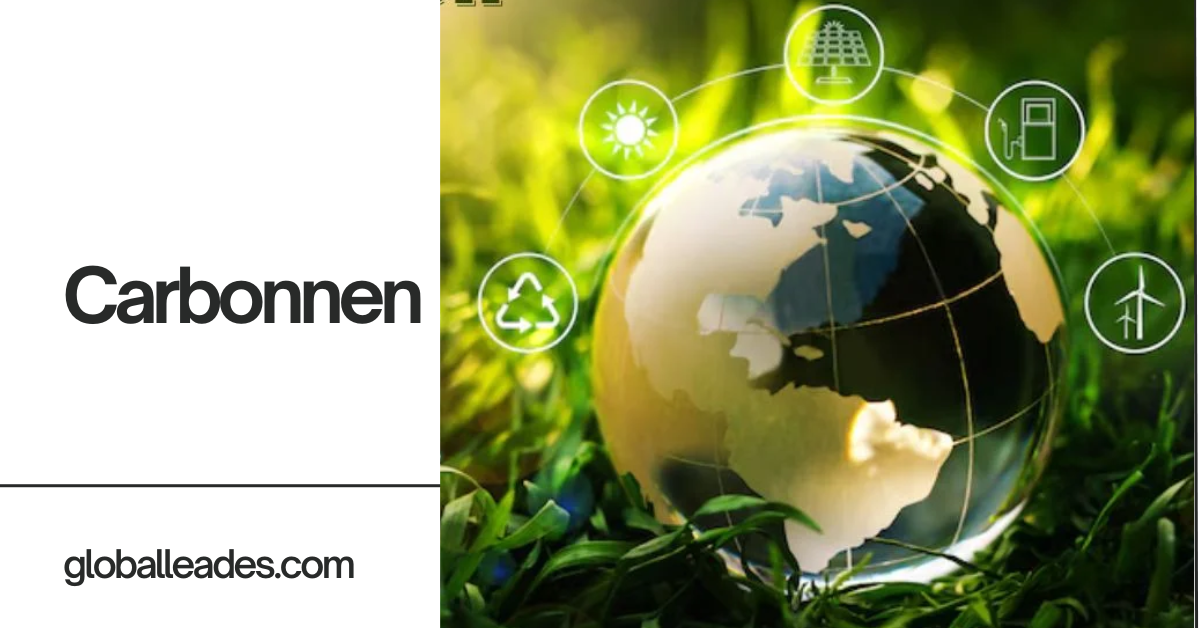Imagine a material that’s stronger than steel, lighter than aluminum, and more versatile than plastic. Welcome to the world of Carbonnen, a Dutch term for carbon, an element that’s transforming industries and revolutionizing the way we live.
In this comprehensive guide, we’ll delve into the properties, applications, and future of Carbonnen, exploring its potential to shape a sustainable tomorrow.
What is Carbonnen?
Carbonnen, the Dutch term for carbon, is a chemical element with the symbol C and atomic number 6. It is the basis of all life on Earth and the fourth most abundant element in the universe. Carbonnen is a versatile element that exists in various forms, each with unique properties and applications.
From the hardest substance known, diamond, to the soft and slippery graphite, Carbonnen’s different forms make it an essential element in various industries. Its ability to form long chains and complex rings makes it the foundation of all organic molecules, including sugars, fats, and proteins, which are the building blocks of life.
Carbonnen’s unique properties, such as its high strength-to-weight ratio, corrosion resistance, and thermal conductivity, make it an ideal material for innovative applications in aerospace, automotive, energy, and construction industries.
How Carbonnen Differs from Traditional Materials
Carbonnen differs from traditional materials in several ways, making it a game-changer in various industries. Here are some key differences:
Lightweight yet Strong: Carbonnen is significantly lighter than traditional materials like steel and aluminum, yet it offers exceptional strength and durability. This unique combination makes it ideal for applications where weight reduction is crucial, such as in aerospace and automotive industries.
Also Read: Cubvh – Revolutionizing Virtual Assistants & 3D Environments
Corrosion Resistance: Unlike traditional materials, Carbonnen is highly resistant to corrosion, which makes it perfect for harsh environments and applications where exposure to chemicals or moisture is a concern.
Thermal Conductivity: Carbonnen has high thermal conductivity, meaning it can efficiently transfer heat, making it suitable for applications like heat sinks and thermal management systems.
Fatigue Resistance: Carbonnen is more resistant to fatigue than traditional materials, which means it can withstand repeated stress and strain without losing its strength or integrity.
Sustainability: Carbonnen is a more sustainable option than traditional materials, as it can be produced from renewable sources and has a lower carbon footprint.
Design Flexibility: Carbonnen’s unique properties allow for innovative designs and complex geometries, enabling the creation of complex structures and shapes that cannot be achieved with traditional materials.
Overall, Carbonnen’s exceptional properties make it an attractive alternative to traditional materials, offering improved performance, reduced weight, and increased sustainability.
Importance of Carbonnen in Modern Industry
Carbonnen plays a vital role in modern industry, driving innovation and transformation across various sectors. Its exceptional strength-to-weight ratio, corrosion resistance, and thermal conductivity make it an essential material for aerospace and automotive industries, where lightweight and durable components are crucial.
In the energy sector, Carbonnen-based materials enhance energy storage and transmission efficiency, paving the way for a more sustainable future. The construction industry benefits from Carbonnen’s high strength and durability, enabling the creation of complex structures and sustainable buildings.
Additionally, Carbonnen’s unique properties make it an ideal material for advanced technologies like nanotechnology, biotechnology, and renewable energy systems. As industries continue to evolve and prioritize sustainability, Carbonnen’s importance will only continue to grow, making it a cornerstone of modern industrial innovation.
Its versatility and potential for innovation have made it an indispensable element in shaping the future of various industries and technologies.
Properties and Forms of Carbonnen
Carbonnen exhibits unique properties in its various forms:
Properties of Carbonnen:
- High Strength-to-Weight Ratio: Carbonnen is incredibly strong and lightweight, making it ideal for applications where weight reduction is crucial.
- Corrosion Resistance: Carbonnen is highly resistant to corrosion, making it perfect for harsh environments and applications where exposure to chemicals or moisture is a concern.
- Thermal Conductivity: Carbonnen has high thermal conductivity, meaning it can efficiently transfer heat, making it suitable for applications like heat sinks and thermal management systems.
- Electrical Conductivity: Carbonnen is an excellent electrical conductor, making it useful for applications like electronics and energy storage.
- Chemical Resistance: Carbonnen is highly resistant to chemicals, making it ideal for applications where exposure to harsh chemicals is a concern.
Also Read: Samsung VC7774 Review – The Ultimate Wireless Vacuum Cleaner
Forms of Carbonnen:
- Diamond: The hardest substance known, diamond is a crystalline form of Carbonnen with exceptional hardness and thermal conductivity.
- Graphite: A soft and slippery form of Carbonnen, graphite is used in applications like lubricants and electrodes.
- Fullerenes: A unique molecular form of Carbonnen, fullerenes have a soccer-ball-like structure and are used in applications like nanotechnology and energy storage.
- Carbon Fiber: A lightweight and high-strength form of Carbonnen, carbon fiber is used in applications like aerospace, automotive, and sports equipment.
- Carbon Nanotubes: A tubular form of Carbonnen, carbon nanotubes have exceptional strength, conductivity, and thermal properties, making them ideal for applications like nanotechnology and energy storage.
- Amorphous Carbon: A non-crystalline form of Carbonnen, amorphous carbon is used in applications like coatings and thin films.
Applications of Carbonnen
Carbonnen’s versatility shines in:
Aerospace Industry
The aerospace industry is one of the primary beneficiaries of Carbonnen’s exceptional properties. Lightweight composite materials made from Carbonnen are used in aircraft and spacecraft structures, reducing weight while maintaining strength and durability. This leads to improved fuel efficiency, increased payload capacity, and enhanced overall performance. Additionally, Carbonnen-based heat shields and thermal protection systems protect spacecraft from extreme temperatures during re-entry, ensuring safe and successful missions.
Automotive Industry
In the automotive industry, Carbonnen is used to create lightweight and high-strength composite materials for vehicle bodies and parts. This reduces the overall weight of the vehicle, improving fuel efficiency and reducing emissions. Carbonnen-based materials are also used in high-performance brakes and clutches, providing improved stopping power and durability. Furthermore, Carbonnen is used in advanced battery systems for electric vehicles, enabling faster charging and longer driving ranges.
Energy Storage and Generation
Carbonnen plays a critical role in the development of advanced energy storage and generation systems. Its unique properties make it an ideal material for fuel cells and electrolyzers, which are used to produce hydrogen for clean energy applications. Carbonnen-based supercapacitors store and release electrical energy quickly and efficiently, making them suitable for regenerative braking and renewable energy systems.
Also Read: Nhentai 455058 – SECRET PASSION UNLEASHED In 2024
Construction and Architecture
In the construction industry, Carbonnen is used to create lightweight and high-strength composite materials for building structures. These materials offer improved durability, reduced maintenance, and enhanced sustainability. Carbonnen-based advanced insulation and thermal management systems reduce energy consumption and improve building comfort. Additionally, Carbonnen is used in sustainable and durable building materials, reducing the environmental impact of construction.
Sports Equipment
Carbonnen’s exceptional strength-to-weight ratio makes it an ideal material for sports equipment. Lightweight and high-strength composite materials are used in bicycle frames and components, golf clubs, tennis rackets, and other high-performance sports gear. This enables athletes to achieve improved performance, speed, and agility while reducing fatigue and injury risk.
Medical Applications
In the medical field, Carbonnen is used in advanced implantable devices and prosthetics due to its biocompatibility and durability. Carbonnen-based materials are also used in tissue engineering and regenerative medicine, enabling the creation of artificial tissues and organs. Additionally, Carbonnen is used in diagnostic and therapeutic tools, such as biosensors and medical imaging devices.
Electronics and Semiconductors
Carbonnen is used in the development of advanced materials for semiconductor manufacturing, enabling the creation of smaller, faster, and more efficient electronic devices. High-performance electronics and optoelectronics benefit from Carbonnen’s exceptional electrical and thermal conductivity. Flexible and wearable electronics also utilize Carbonnen-based materials, enabling new applications and form factors.
Environmental Remediation
Carbonnen plays a crucial role in environmental remediation efforts. Advanced materials made from Carbonnen are used in water purification and filtration systems, removing contaminants and pollutants from water sources. Carbonnen-based carbon capture and utilization technologies reduce greenhouse gas emissions and convert CO2 into valuable products. Additionally, Carbonnen is used in soil remediation and pollution control, restoring contaminated soil and preventing further pollution.
The Environmental Impact of Carbonnen
The environmental impact of Carbonnen is a crucial consideration, as it affects the ecosystem throughout its lifecycle. During production, Carbonnen requires significant energy, leading to greenhouse gas emissions and contributing to climate change.
Also Read: Bitcoin FintechZoom – Latest Trends and Analysis 2024
Additionally, resource extraction for Carbonnen can lead to resource depletion and environmental degradation. In the use phase, Carbonnen-based products have a carbon footprint, and waste generation is a concern, including packaging materials, end-of-life products, and manufacturing by-products.
At the end-of-life phase, Carbonnen-based materials are difficult to recycle, leading to waste accumulation and potential environmental harm. Furthermore, Carbonnen is non-biodegradable, persisting in the environment for centuries and contributing to microplastic pollution and potential harm to wildlife.
To mitigate these impacts, sustainable production methods, design for recyclability, and responsible end-of-life management practices are essential. By adopting these strategies, we can reduce the environmental impact of Carbonnen and promote a more circular and regenerative economy.
Innovative Products and Technologies
Carbonnen inspires innovative products and technologies:
Carbonnen’s unique properties have led to the development of innovative products and technologies that transform industries and improve our daily lives.
Carbon Fiber Hinges
Carbonnen-based carbon fiber hinges are lightweight, durable, and resistant to corrosion, making them ideal for aerospace and industrial applications.
Carbon Plate Running Shoes
Carbonnen-infused carbon plates in running shoes enhance performance, providing improved cushioning, support, and propulsion.
Carbon Fiber Reinforced Polymers (CFRP)
CFRP combines Carbonnen fibers with polymers, creating lightweight, high-strength materials for aerospace, automotive, and construction applications.
Carbon Nanotube-Based Energy Storage
Carbonnen nanotubes improve energy storage and transmission efficiency in batteries, supercapacitors, and fuel cells.
Carbon Fiber 3D Printing
Carbonnen-based carbon fiber 3D printing enables rapid production of complex structures, revolutionizing manufacturing and prototyping.
Carbonnen-Based Water Purification
Carbonnen-based materials and technologies remove impurities and contaminants from water, ensuring clean drinking water and reducing environmental pollution.
Carbon Fiber Bike Frames
Carbonnen-based carbon fiber bike frames provide exceptional strength, durability, and lightweight performance for professional cyclists and enthusiasts.
Also Read: BlueFire Wilderness Lawsuit
Carbonnen-Infused Biomedical Implants
Carbonnen-infused biomedical implants offer improved biocompatibility, durability, and functionality for medical applications.
Challenges and Limitations of Carbonnen
Despite its potential, Carbonnen faces challenges:
Challenges of Carbonnen
- High Production Costs: Carbonnen production is energy-intensive and expensive, limiting its widespread adoption.
- Scalability: Scaling up Carbonnen production while maintaining quality and consistency remains a significant challenge.
- Recyclability: Carbonnen-based materials are difficult to recycle, leading to waste accumulation and environmental concerns.
- Interfacial Bonding: Achieving strong interfacial bonding between Carbonnen fibers and matrices can be challenging.
- Moisture Sensitivity: Carbonnen-based materials can be sensitive to moisture, affecting their performance and durability.
Limitations of Carbonnen
- Standardization: Lack of standardization in Carbonnen production and processing hinders industry-wide adoption.
- Public Awareness: Limited public awareness and understanding of Carbonnen’s benefits and applications hinder its adoption.
- Research and Development: Further research and development are needed to overcome the challenges and fully realize Carbonnen’s potential.
- Material Compatibility: Carbonnen may not be compatible with all materials, limiting its use in certain applications.
- Environmental Impact: The environmental impact of Carbonnen production and disposal is a concern that needs to be addressed.
Future of Carbonnen
The future of Carbonnen holds immense promise, with its unique properties and versatile applications poised to transform various industries. As research and development continue to advance, Carbonnen’s production costs are expected to decrease, making it more accessible and widespread.
Its potential in energy storage, generation, and transmission is vast, with Carbonnen-based materials and technologies playing a crucial role in the transition to a sustainable and renewable energy future.
Additionally, Carbonnen’s use in aerospace, automotive, and construction industries is expected to increase, driven by its exceptional strength-to-weight ratio and durability. Furthermore, innovations in Carbonnen-based biomedical implants, water purification systems, and 3D printing technologies will improve lives and revolutionize industries.
Also Read: превоодач – Mastering the Art of Translation
As the world shifts towards a more sustainable and technologically advanced future, Carbonnen is poised to play a vital role, enabling breakthroughs and innovations that will shape the decades to come.
Conclusion
In conclusion, Carbonnen is a revolutionary material with exceptional properties and versatile applications. Its unique combination of strength, durability, and conductivity makes it an ideal material for various industries, including aerospace, automotive, energy, and biomedicine.
While challenges and limitations exist, ongoing research and development are addressing these issues, paving the way for widespread adoption. As the world continues to evolve and prioritize sustainability, Carbonnen’s role in shaping the future of technology and innovation is undeniable.
With its vast potential and transformative capabilities, Carbonnen is poised to leave a lasting impact on humanity and the planet.
FAQs
Can Carbonnen be used in musical instruments?
Yes, Carbonnen’s unique properties make it an ideal material for creating high-quality musical instruments with enhanced sound resonance and durability. Carbonnen-based instruments are already being used by musicians worldwide.
Is Carbonnen used in food packaging?
Yes, Carbonnen-based materials are being explored for food packaging due to their antimicrobial properties and ability to extend shelf life. Carbonnen-based packaging can help reduce food waste and improve food safety.
Can Carbonnen be used in 3D printing of organs?
Yes, Carbonnen’s biocompatibility and strength make it a promising material for 3D printing of organs and tissues. Researchers are exploring Carbonnen-based biomaterials for creating functional organs for transplantation.
Is Carbonnen used in water desalination?
Yes, Carbonnen-based membranes are being developed for water desalination due to their high flux and salt rejection capabilities. Carbonnen-based desalination technologies can help address global water scarcity challenges.
Can Carbonnen be used in space exploration?
Yes, Carbonnen’s exceptional strength-to-weight ratio and durability make it an ideal material for spacecraft and satellite components. Carbonnen-based materials are being explored for use in future space missions.
Is Carbonnen used in geothermal energy?
Yes, Carbonnen-based materials are being used to enhance geothermal energy systems due to their high thermal conductivity and corrosion resistance. Carbonnen-based geothermal systems can improve energy efficiency and reduce costs.
Can Carbonnen be used in advanced prosthetics?
Yes, Carbonnen’s biocompatibility and strength make it a promising material for creating advanced prosthetic limbs with enhanced functionality and durability. Carbonnen-based prosthetics can improve the quality of life for amputees worldwide.




